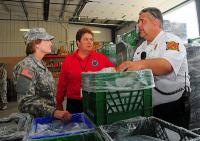-
Three new Engineering Research Centers to advance U.S. resiliency, sustainability

The NSF awards $55.5 million for compact mobile power, off-grid water treatment, and nature-inspired soil engineering. The NSF says that innovations that improve the affordability, availability, quality, and resilience of infrastructure services will enhance the nation’s economic competitiveness and societal well-being.
-
-
Price of wind energy in U.S. at an all-time low, spurring demand

Wind energy pricing is at an all-time low, according to a new report released by the U.S. Department of Energy. The prices offered by wind projects to utility purchasers averaged under 2.5¢/kWh for projects negotiating contracts in 2014, spurring demand for wind energy.
-
-
Cars to harvest energy from bumps in the road

The 255 million cars on the road in the United States account for 40 percent of the country’s fuel consumption. Most of that fuel is wasted. Engineers may have a partial solution: harvesting energy from the car’s suspension. Only 10 to 16 percent of the fuel a car consumes is actually used to drive — that is, to overcome road resistance and air drag. Most of the rest is lost to heat and other inefficiencies. With clever engineering, however, that deficit can be reduced. Three major opportunities exist for recovering or generating energy while driving: the waste heat given off by the engine, the kinetic energy absorbed during braking, and the vibrational energy dampened by the shock absorbers.
-
-
Tackling urban water crises

With drought conditions putting a strain on resources throughout South Florida, FIU researchers are investigating long-term solutions to water crises as part of a newly launched consortium. The Urban Water Innovation Network (UWIN) comprises fourteen academic institutions and key partners across the United States. The UWIN researchers hope to create technological, institutional, and management solutions that will help communities increase the resilience of their water systems and enhance preparedness for responding to water crises.
-
-
Building resilient urban infrastructure to cope with climate challenges
In addition to urban flooding, global climate change is predicted to bring increased coastal flooding, like that associated with Hurricane Katrina and Superstorm Sandy, as well as extreme heat. As extreme weather events like these occur more frequently, global climate change may demand that we recalibrate our definition of “rare.” Historically, infrastructure to mitigate flooding and extreme heat has been designed to be fail-safe, meaning that it is designed to be fail-proof. But recently we have seen that fail-safe can be a dangerous illusion. Fifty researchers from different disciplines from fifteen institutions have teamed up to explore these challenges and to change the way we think about urban infrastructure.
-
-
Smart hand pumps to bring a reliable water service to rural Africa
Worldwide 780 million people live without basic and reliable water supplies, with parts of rural Africa facing particular challenges achieving water security. Groundwater from hand pumps is a primary water supply for many communities — but up to one third of these pumps are out of action at any one time and can take weeks to be repaired. Researchers have created a device that generates data on hand pump usage and transmits this information over the mobile phone network. The smart hand pump, being trialed in rural Kenya, alerts the maintenance team if the hand pump is not functioning.
-
-
$4 million awarded to support earthquake early warning system in Pacific Northwest
The U.S. Geological Survey (USGS) last week has awarded approximately $4 million to four universities — California Institute of Technology, University of California, Berkeley, University of Washington, and University of Oregon — to support transitioning the ShakeAlert earthquake early warning (EEW) system toward a production stage. A functioning early warning system can give people a precious few seconds to stop what they are doing and take precautions before the severe shaking waves from an earthquake arrive.
-
-
Confronting weather extremes by making infrastructure more resilient
South Florida’s predisposition to weather extremes renders the region’s infrastructure acutely vulnerable. But weather extremes are not exclusive to South Florida. The Urban Resilience to Extreme Weather-Related Events Sustainability Research Network (UREx SRN), a newly formed team of researchers, is addressing these challenges on an international scale.
-
-
Forecasting tool reduces costly power grid errors

Accurately forecasting future electricity needs is tricky, with sudden weather changes and other variables impacting projections minute by minute. Errors can have grave repercussions, from blackouts to high market costs. Now, a new forecasting tool that delivers up to a 50 percent increase in accuracy and the potential to save millions in wasted energy costs has been developed by researchers.
-
-
Coral reefs could protect Pacific islands from rising seas – but only if global warming slows
The coral reefs that have protected Pacific Islanders from storm waves for thousands of years could grow rapidly enough to keep up with escalating sea levels if ocean temperatures do not rise too quickly, according to a new study. If global temperatures continue to rise and thus retard the growth of these natural storm barriers, the homelands of millions of people on lands throughout the Pacific Ocean will be in jeopardy.
-
-
Chemical plants provided incorrect information about toxic release risks: GAO
A new report from the Government Accountability Office (GAO) recommends that federal agencies should more carefully verify information provided by chemical facilities and improve compliance with safety standards. DHS collected data on some 37,000 facilities handling dangerous chemicals, and identified 2,900 which were especially risky. Those plants, typically located near residential areas, posed more risk of mass casualty events in case of a terrorist- or accident-induced chemical release. The report criticizes DHS officials for relying on self-reported data — without checking and verifying the information chemical operators provided.
-
-
Communities near chemical plants should develop preparedness, response plans: Experts
Researchers found that despite the 2007 passage of the Chemical Facility Anti-Terrorism Standards (CFATS), only a few chemical facilities have completed the necessary security measures implementation. The authors recommend that communities should not wait for CFATS to be implemented before developing their own preparedness and response plans in anticipation of possible chemical disasters in the future, whether caused by terrorism or accident.
-
-
New guidance on estimating area affected by a chlorine release issued
Arlington, Virginia-based Chlorine Institute (CI) has issued a new version of Pamphlet 74 - Guidance On Estimating the Area Affected By A Chlorine Release. The new version, Edition 6, dated June 2015, reflects CI’s collaboration with the U.S. Department of Homeland Security’s Chemical Security Analysis Center and incorporates information obtained from the DHS “Jack Rabbit I” chlorine release field tests.
-
-
U.S. military bases vulnerable to cyberattacks on their power, utility systems
U.S. military bases are at risk for cyberattacks against the bases’ power grid and other utility systems, according to a new report on defense infrastructure from the Government Accounting Office. The 72-page GAO document concludes military bases “may be vulnerable to cyber incidents that could degrade operations and negatively impact missions.”
-
-
Different lessons from past floods
More and more frequent extreme weather events lead to new projects on risk management and spatial planning. Past experiences represent an added value and suggest the importance of greater involvement of local communities. Luckily, past mistakes can sometimes be useful for present or especially future decisions. This can apply to spatial planning and management in response to natural disasters and extreme weather events.
-
More headlines
The long view
Helping Strengthen America’s Critical Infrastructure
Everyday life depends on a robust infrastructure network that provides access to running water, communications technology and electricity, among other basic necessities. The experts who keep our national infrastructure secure and resilient also need a strong network to share their knowledge and train the next generation of professionals capable of solving complex infrastructure challenges.
AI and the Future of the U.S. Electric Grid
Despite its age, the U.S. electric grid remains one of the great workhorses of modern life. Whether it can maintain that performance over the next few years may determine how well the U.S. competes in an AI-driven world.
Using Liquid Air for Grid-Scale Energy Storage
New research finds liquid air energy storage could be the lowest-cost option for ensuring a continuous power supply on a future grid dominated by carbon-free but intermittent sources of electricity.
Enhanced Geothermal Systems: A Promising Source of Round-the-Clock Energy
With its capacity to provide 24/7 power, many are warming up to the prospect of geothermal energy. Scientists are currently working to advance human-made reservoirs in Earth’s deep subsurface to stimulate the activity that exists within natural geothermal systems.
Experts Discuss Geothermal Potential
Geothermal energy harnesses the heat from within Earth—the term comes from the Greek words geo (earth) and therme (heat). It is an energy source that has the potential to power all our energy needs for billions of years.
